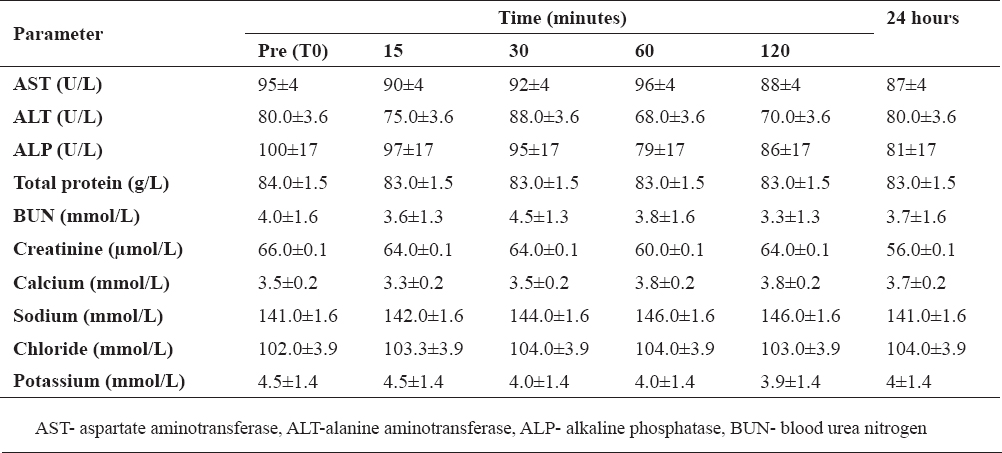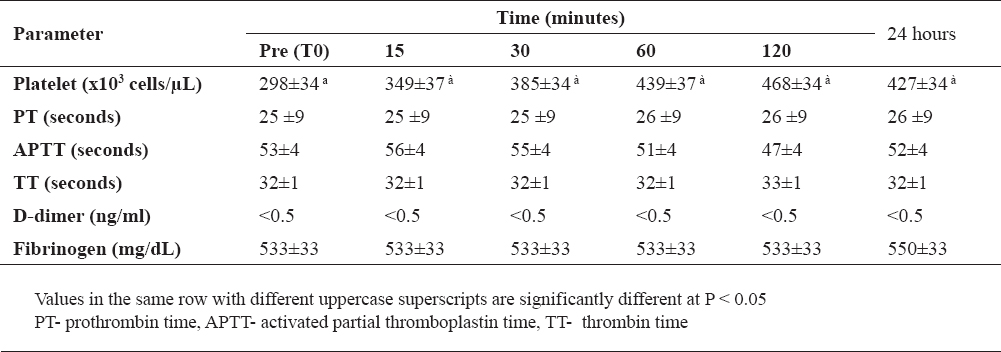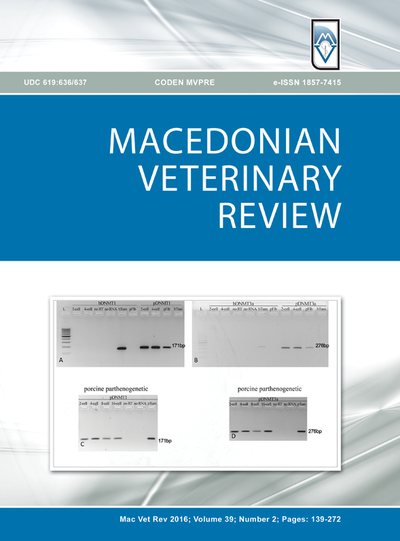INTRODUCTION
Vitamin K (Phytonadione) is widely used in dairy cattle practices as an emergency treatment of uncontrollable hemorrhage (1, 2). In cattle, there are no scientific research on safety and efficacy of the drug. It is believed that vitamin K is important for the synthesis and activation of coagulation factor II (prothrombin), factor VII (proconvertin), IX (christmas factor) and factor X (3). Clinically, other common indications of the use of vitamin K in dairy cattle include cases suffering from coagulation disorders caused by vitamin K deficiency or interference with vitamin K activity, hypoprothrombinemia induced by ingestion of anticoagulant rodenticides, and hypoprothrombinemia caused by consumption of bishydroxycoumarin found in spoiled and moldy sweet clover (3).
Although the mechanism by which vitamin K1 is effective in cases affected with bleeding disorders due to, for example, moldy sweet clover toxicity (dicoumarol), its mechanism and effects in normal cattle and in cattle with none specific causes of bleeding are not fully elucidated yet. It has been reported that in cattle fed moldy sweet clover, levels of prothrombin time returned to normal within 24 hours after a single injection of vitamin K1 at 1.1-3.3 mg/kg intramuscularly (1, 2). Therefore, this study was performed to evaluate the clinical, hematological and serum biochemical effects associated with a single intramuscular injection of vitamin K1 at 2.5 mg/kg to normal Holstein dairy cattle. In addition, effects of vitamin K1 on various clotting times and other coagulation parameters were assessed.
MATERIAL AND METHODS
Animals
The procedures performed in this study were approved by the Jordan University of Science and Technology Animal Care and Use Committee. Six healthy adult (2-4 years of age) Holstein dairy cows were used in this study. Prior to the start of the study, the health status of each animal was determined by performing a general physical examination, complete blood cell count (CBC), and serum biochemical prfile. Only healthy cows were used in the study.
Drug administration and clinical monitoring
Each cow was administered single intramuscular injection of vitamin K1 (Cenavisa, Spain) at a dose rate of 2.5 mg/kg. Drug safety was evaluated by monitoring the rectal temperature using an electrical thermometer inserted into the rectum for 2 minutes; the heart rate by listening to the heart beats using a stethoscope for 1 minute; the respiratory rate by counting the number of chest excursion in 1 minute; the capillary refill time by finger pressing on the vulvar mucosa; the rumen motility by listening and counting rumen motility sounds in 3 minutes using a stethoscope; and behavioral changes (i.e., salivation, urination, defecation, trembling, etc.) by observation immediately after administration and for 24 hours after injection.
Laboratory evaluation
Whole blood samples were collected in plain tubes, EDTA, and Citrate-containing tubes and were analyzed within 2 hours after collection. Samples were collected before drug administration (Time 0), and at 15, 30, 60, and 120 minutes and 24 hours after administration via vein puncture from the jugular vein from each animal. Hematology and serum biochemical analyses were determined using previously reported methods (4). Parameters investigated were: total white blood cell count (WBC), red blood cell count (RBC), platelets counts, hemoglobin concentration (Hb), packed cell volume (PCV), mean corpuscular volume (MCV), mean corpuscular hemoglobin concentration (MCHC), and fibrinogen concentration.
After centrifugation of clotted whole blood at 1500g for 10 minutes, serum was analyzed to determine total protein, blood urea nitrogen, creatinine, aspartate aminotransferase (AST), alanine aminotransferase (ALT), alkaline phosphatase (ALP), calcium, sodium, chloride, and potassium. Whole blood samples in Citrate-containing tubes were used to determine activated partial thromboplastin time [APTT] (STA- C.K. Prest, Stago, France), prothrombin time [PT] (Néoplastine CI Plus, Stago France), thrombin time [TT](STA –Thrombin, Stago, France), D-Dimers (D-Di Test, Stago, France) using commercially available kits according to manufacturers’ recommendations.
Statistical Analysis
Data was presented as mean ± standard error (SE). Repeated measure analysis of each of the evaluated variables was performed using GLM repeated measures. Post-hoc pairwise comparisons were performed using Bonferroni test. Differences were considered statistically significant if the P≤ 0.05. The analysis was conducted using statistical software (SPSS, Version 19.0, SPSS Inc, Chicago, USA).
RESULTS
All cows tolerated well the intramuscular injection of 2.5 mg/kg vitamin K1. The heart rate, respiration rate, rectal temperature and rumen motility patterns remained within normal limits during the observation period (24 hours). There were no abnormal behavioral activities associated with the injection of the drug. In the hematology and serum biochemistry profiles, all values were within normal range (Tables 1, 2).
Table 1. Means ± SE for certain hematology parameters in healthy adult dairy cows before and after administration of vitamin K1 intramuscularly
Table 2. Means ± SE for certain blood biochemistry parameters in healthy adult dairy cows before and after administration of vitamin K1 intramuscularly
In the clotting profile, the only significant effect was an increased platelets counts starting from 15 minutes after administration that remained high at 24 hours after administration (Table 3).
Table 3. Means ± SE of blood clotting factors and platelets in healthy adult dairy cows before and after administration of vitamin K1 intramuscularly
DISCUSSION
Injected cattle suffering from bleeding due to unspecified origin such as bloody milk, and hemorrhagic diathesis with vitamin K1 is a common practice (4, 5). Although, clinical improvement of such animals after drug administration is difficult to assess, other unwanted or undesirable side effects can occur such as hypersensitivity reactions or non-specific systemic toxic effects (1, 2). Unfortunately, clinical efficacy and safety studies concerning this commonly used drug in cattle practice are currently lacking. In this study, the administration of vitamin K1 to normal adult dairy cows at therapeutic dose (2.5 mg/kg) resulted in a significant increase in platelets numbers. It has been reported that vitamin K administration quantitatively improves platelet functions, but no effects were seen concerning other clotting factor functions in normal subjects (6).
Vitamin K1 is naturally synthesized by ruminal and intestinal bacteria and, in most cases, the synthesized amounts meet daily requirements of cows. However, supplemental K1 is needed in special cases (i.e., cows fed moldy sweet clover) (7). Vitamin K controls the synthesis of a group of coagulation factors such as factor II (prothrombin), VII, IX, and X in the liver. Other coagulation factors that are dependent on vitamin K are protein C, S, and Z. Protein C and S are anticoagulants (1, 2).
CONCLUSION
Results of this study indicate that vitamin K1 administration to dairy cattle is safe and may result in some beneficial therapeutic effects in cases with minor bleeding tendencies such as vitamin K deficiency associated hemorrhagic diathesis or in cases with mild bleeding due to external trauma such as bloody milk.









